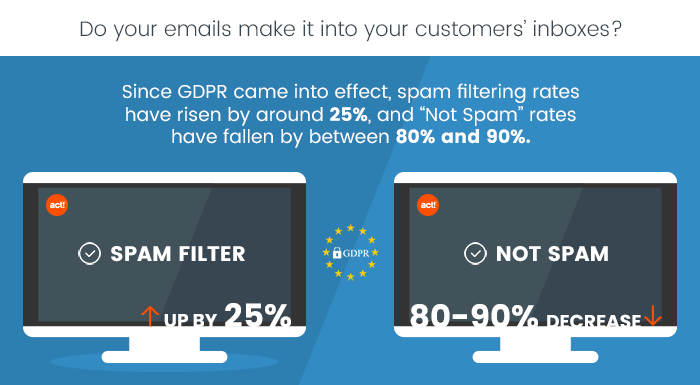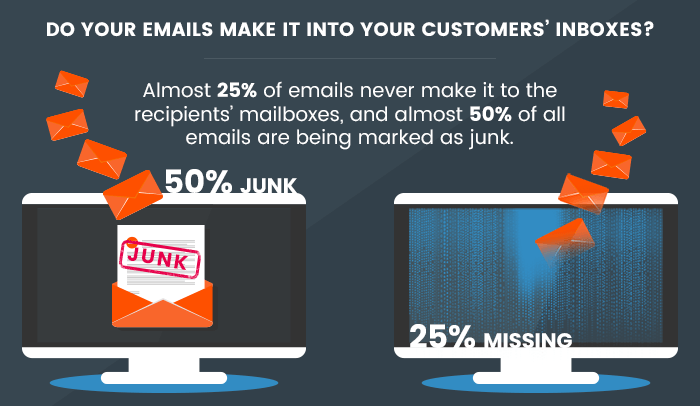What is email deliverability? Picture this scenario: you’ve crafted the perfect email copy, you’ve spent hours working on creating a beautiful, on-brand design, and you’ve tested everything many times to ensure it’s all technically perfect. You’re sure this email is going to have a great click-to-convert rate, and generate a ton of leads. But your perfect marketing email falls flat at the first hurdle –– making it into your customers’ inboxes.
It’s a common problem, with almost a quarter of emails never making it to the recipients’ mailboxes, and almost half of all emails being marked as junk. If your emails aren’t being delivered to your customers, you’re wasting your time and money.
With data privacy and security a key concern for users, marketers have to be ever more careful to ensure that their emails meet industry standards and best practices, or they will end up falling foul of spam filters. The effects of new data privacy regulations such as GDPR are also taking their toll, where spam filtering rates rose by around 25%, and “Not Spam” rates fell by between 80% and 90%.

That’s why it’s important to focus on maximizing email deliverability and managing your sender score and reputation if you want to run successful email marketing campaigns.
What is email deliverability?
Email deliverability –– and optimal placement in your customers’ inbox –- is key to the success of any marketing campaign.
Inbox providers such as Outlook and Gmail, and email filtering services such as SpamTitan and Symantec, track your email sending history and behavior to gauge if you are likely to be sending high-quality emails, or spamming your customers. They then use algorithms to decide whether your sender reputation is high or low and whether your email will be sent to spam, or delivered to a customer’s inbox.
Email deliverability can refer to both email delivery as well as inbox placement. Email delivery is whether your message is delivered or blocked by the IP provider from reaching the server and rejected completely, while inbox placement refers to whether the message ends up in the junk or bulk folder, or whether it makes it to a customer’s inbox.
There are a number of things that companies do that hurt their email deliverability rate, and make it more likely that their email will end up being marked as spam. These elements include:
- Sending email from a free domain
- Including too many images
- Using URL shorteners
- Poor list quality with too many spam trap or invalid/incorrect/inactive email addresses
- Lack of email authentication
- Making it difficult to unsubscribe
- Using single opt-in
- Poor sender reputation.
What is sender reputation?
Poor sender reputation is one of the main reasons why emails are either rejected completely by the ISP, or end up in spam. A good sender reputation makes it more likely that you will get a higher inbox placement, which will result in more opportunities for conversion. A bad reputation increases the likelihood of your email being marked as spam, or being blocked altogether.
You can use a tool such as Return Path’s Sender Score to find out your sender reputation, as well as discover how mailbox providers view your IP address. The kind of metrics that are used to measure your sender score include:
- Mailing to unknown users (who haven’t subscribed)
- Subscriber engagement
- Mailing to spam traps
- Being on industry blacklists and whitelists
- Unsubscribe rate
- Complaints about spam.
How can I improve my email deliverability rates?
Improving your email deliverability rates doesn’t have to be hard. It’s all about ensuring you’re engaging your customers by providing them with marketing emails that are useful, relevant, and personalized, and that they want to receive. Here are some ways you can make sure that you’re staying in your customers’ good books, and ensuring that you reach their inbox every time.
Get permission
Permission is the single most important thing you must get right when it comes to email deliverability (assuming that all of the technical configuration is set up properly). It’s also the most common thing that companies get wrong. It’s very important that you only send marketing emails to recipients that have provided explicit permission for you to do so.
For example, getting a list of email addresses from people who have attended a trade show or have purchased a product might imply that you have permission to send marketing communications, but this implied permission is not always enough. Sometimes it might be sufficient, but this is not true in all cases, and it’s important to get very clear on when you can automatically send communication to people who have provided their email address, or when you need to seek additional permission.
The same applies to someone who provides their email address so they can download a copy of an e-book from your site. That doesn’t mean you have their permission to start sending them marketing emails. Just because you have their email address doesn’t mean they have subscribed to your email lists. This is another reason to employ double-opt-in for subscriptions.
Provide high-quality content
Make sure that every email you send includes high-quality, relevant content that is free of errors or typos. This applies both to the content of the email, and the subject line. Avoid spammy keywords in both instances, or your email will be flagged up as potential junk email. Definitely don’t try and trick your customers with a subject line that is too sensational, or doesn’t reflect the content of the email.
Maintain your email lists
It’s good practice to remove email addresses from your lists that haven’t opened or clicked in the past six months (although you could try a re-engagement campaign first). If your open rate is low because you’re sending to users that aren’t engaging, that can hurt your deliverability rate. Also don’t suddenly start sending marketing emails to recipients if you haven’t emailed them in the last six months.
Follow subscription best practices
If you want to ensure the best email deliverability rates for your business then make it easy for recipients to unsubscribe from emails. It’s also a good idea to implement double opt-in for new subscriptions to ensure recipients really want to receive your emails and to avoid spam trap addresses. Make sure you set expectations around what the emails will be about, and when and how often they will receive them.
We recommend sticking to a consistent schedule, so you don’t bombard customers with emails, but you send them frequently enough so they remember your brand. General consensus suggests that any more than eight emails per month is a bad idea.
Use customer segmentation effectively
Effective use of segmentation will almost certainly boost your email deliverability. According to research, segmented emails have a 14.31% higher open rate than non-segmented campaigns, as well as a 100.95% higher click rate, and a 4.65% lower bounce rate.
By segmenting your customers by factors such as email type, demographic, location, past purchases or shopping behavior, and stage in the buyer journey, you can ensure you’re sending them the most relevant content that is personalized to their needs.
Stay compliant
Aside from GDPR, there are other regulations that govern the way you can and can’t use customer data. These include the CAN-SPAM Act, which provides guidelines for commercial emails and makes it mandatory for senders to allow recipients to opt-out of their messages. Make sure you stay up-to-date with these regulations or you’ll face not just the annoyance of your customers, but also hefty fines.
Conclusion: build trust with your customers
While it’s important to make sure you have all the technical aspects (URLs, image placements, authentication, etc) in place to make sure you have a high sender score and good email deliverability, it’s also crucial to create and send relevant, engaging, and useful emails. You need to develop trust not just with the ISPs, inbox providers, and email spam filters, but also with your customers.
If you want to maximize the ROI of your email marketing campaigns, then marketing automation software such as Act! Marketing Automation can help. With marketing automation software, you can automate your outreach, segment customers, and automatically send emails to these targeted lists based on pre-defined criteria and triggers. These response-driven marketing campaigns can help you better prospect and engage customers, which will help you generate leads that will make a difference to your business.







